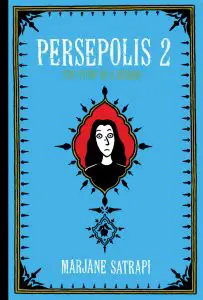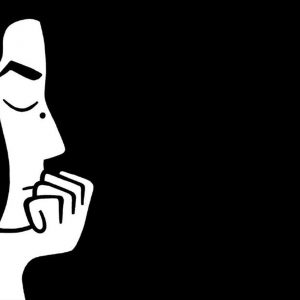In the graphic novel Persepolis by Marjane Satrapi, the author uses words as well as illustrations in order to deliver the story of a young Iranian girl raised by a modern family in a traditionalist country. Satrapi composes her illustrations to reflect the current emotion or state of her character in order to accentuate certain events. She often uses splash frames and incorporates Persian flourishes into her artwork.
Some character issues that are expressed through panel composition are Marjane’s identity crises as modern or traditionalist and Iranian or Austrian, her eelings of isolation in deserted Tehran, her feelings of distance and helplessness when leaving her parents at the airport, and homesickness brought up by blatant differences in Iranian and Austrian parties. One example of Satrapi’s indication of character issues through panel design occurs early in the book, when the author is still introducing the reader to the protagonist.
Alienation In Persepolis
The story follows the author’s childhood in Iran during the Islamic Revolution. Persepolis is a story of alienation, both from her homeland and from the world around her. As a child, Marjane is forced to wear a veil and live under the rule of strict Islamic law. She is also forbidden from attending parties or listening to music.
As she gets older, Marjane becomes more and more alienated from her country and its customs. When she is finally allowed to leave Iran, she does so with relief. Persepolis is a moving and powerful story about one girl’s experience of growing up in a country that is undergoing radical change.
Persepolis is a story about the author’s experience of alienation. She grew up in Iran during the Islamic Revolution, and her family was forced to flee the country. They settled in France, but Persepolis is a story about her struggle to find her place in a new culture. The author uses her experiences to explore the theme of alienation, and how it can affect people’s lives. Persepolis is a powerful story that will resonate with anyone who has ever felt like they don’t belong. Whether you’re dealing with cultural or social alienation, Persepolis is a must-read that will help you understand and cope with these feelings.
 Persepolis Identity
Persepolis Identity
Persepolis is a story about identity. It is the story of Marjane Satrapi, a young girl growing up in Iran during the Islamic Revolution. Persepolis is a coming-of-age story, and it is also a story about how Marjane Satrapi comes to understand her own identity.
Persepolis is set against the backdrop of the Iranian Revolution, and it chronicles Marjane Satrapi’s struggle to find her place in a world that is changing rapidly around her. The revolution has a profound impact on Marjane’s life, and she must grapple with her own identity in the face of political turmoil and social upheaval.
Satrapi’s graphic novel is both an intimate and universal story about the complexities of identity and the struggle to find one’s place in the world. Through vivid illustrations and raw, honest prose, Persepolis explores themes that are relevant to anyone who has ever struggled to figure out who they truly are. Ultimately, Persepolis is a powerful meditation on what it means to be human, and it serves as a reminder that we can all relate to one another no matter how different our backgrounds may seem.
The reader is made aware of an ongoing struggle in identity in a panel that shows Marjane split in down the middle: one half has her hair and clothes covered with a veil and is set against a background of traditional Persian flourishes. This half represents Marjane’s identity as an Iranian and reveals her fidelity to her religion. The other half of her is shown wearing modern clothes and no veil over her hair, and is accompanied by a background filled with images of gears and tools. This half displays how Marjane is affected by her modern upbringing.
The image is accompanied by the statement that “(Marjane) really didn’t know what to think about the veil deep down. (She) was very religious but as a family (they) were very modern and avant-garde”(6/1). The image as a whole introduces the reader to Marjane’s identity risis, which she struggles with throughout the book. In the beginning while she is living in Iran, she struggles with balancing her religious belief against her modern beliefs and morals. When she goes to Austria, she struggles with balancing her identity as an Iranian against her life in a modern western society.
Another example of the main character’s emotion being reflected in her artistic composition can be found in the frame that occurs after the bombing of Tehran when all the civilians had decided to leave the city. The text at the top of the frame reads. “Now that Tehran was under attack, many fled. The city was deserted. As for us, we stayed. Not just out of fatalism. If there was to be a future, in my parents’ eyes, that future was linked to my French education. And Tehran was the only place I could get it” (137/1).
This passive statement is accompanied by a serene image in comparison with the frames leading up to it, but the image is made impactful by the large size of it as well as the composition: the frame is a bird’s eye image of Marjane walking down a deserted street by herself. Her back is shown from somewhat far away, making her seem very small and alone and the streets are empty of cars and people. This can represent Satrapi’s feelings of isolation and loneliness. Another significant component to the composition of the frame is the positioning of Marjane in the image.
She is very close to the bottom of the frame, walking down the deserted road that stretches to the border on the opposite end of the image. This can indicate that Marjane feels that staying in the deserted city of Tehran is tantamount to walking down an empty road with no end in sight. The image, while maintaining the appearance of emptiness, employs many shadows to make the street appear drab and unwelcoming. This can display Marjane’s feelings of resentment toward her confinement in the deserted city.
Another example of Satrapi’s use of this technique occurs in the panel in which Marjane is accompanied by her parents to the airport so she could go live in Austria. On the previous page she has a tearful parting with her parents, and then she goes behind a glass wall to get her bags checked where she can see her parents but they are still separated by a glass wall. Before she leaves her parents, she turns to see them once more before she goes. The next panel shows her father catching her mother, who has fainted.
Her father’s face is shadowed, which can show the anguish he feels in watching his child leave him as well as witnessing his wife’s despair. While the figure of Marjane’s parents occupies the focal point of the image, Marjane can be seen in the background pressing against the glass wall with a look of horror on her face as she witnesses he r parents’ sorrow. They both have their backs to Marjane, who seems small and insignificant in comparison. The glass window as well as the distance separating Marjane from her parents can represent the distance she already senses between them as well as the elplessness she feels in trying to comfort them.
This image is accompanied by the statement “It would have been better to just go”(153/3). Once she is living in Austria, Marjane is portrayed as being an outsider through plot as well as panel design. When Marjane is at an Austrian party, she says that the party is “… not what (she) imagined. In Iran, at parties, everyone would dance and eat. In Vienne, people preferred to lie around and smoke. And then, (she) was turned off by all these displays of public affection. What do you expect, (she) came from a traditionalist country”(185/1). This statement is accompanied by an image of Marjane at a party where people are smoking and making out.
The image is mostly black with white Persian flourishes against the wall that look like smoke. Marjane is a small figure in the large frame, sitting alone in the corner. The insignificant, isolated image of her within the large panel can represent her feelings of desolation and loneliness, while the dark coloring of the panel and be a representation of how Marjane felt the room in which the party takes place to be intimidating or uninviting. Additionally, the Persian flourishes embedded in the image can how how the party has brought up her homesickness, as the caption on the image may suggest.
The contrast of the white Persian flourishes against the black wall can also be seen as emblematic of Satrapi’s views on the stark differences between parties in Iran and Austria. Once Marjane is back in Iran, she sees the damage inflicted upon the cities by the war. One frame shows Marjane’s silhouette standing far away in the middle of a street with empty, abandoned buildings. The street she is standing on is at the top of the panel, and below it the reader can see an x-ray view of what is under the ground she is standing on. It is full of skeleton faces and figures of skeletons displaying feelings of despair.
Above the image reads the words “I felt as if I were walking through a cemetery”(251/4). The skeletal figures are meant to represent the sheer number of deaths that have occurred due to the war as well as the effect that these deaths have had on the country. The large size of the skeletons compared to the small image of Marjane can represent how she feels insignificant in the war because she abandoned her country during the most violent duration. Her feelings of guilt are also portrayed by her position in the image: she is standing bove the images of the dead, which would be considered disrespectful in an actual cemetery.
Throughout the book, the reader can better understand character issues through panel composition, such as Marjane’s struggle with identity, her dislike of living in abandoned Tehran, her feelings toward leaving her parents, and her homesickness at Austrian parties. The composition and design of the panels in Persepolis are an important tool for the reader to understand what the protagonist is feeling. The illustrations are often indicative of Marjane’s emotions and are helpful in understanding statements made throughout the novel.